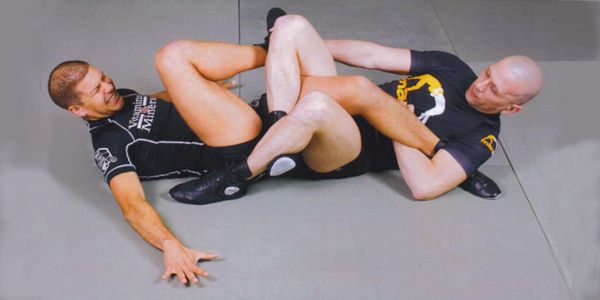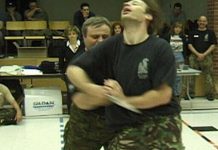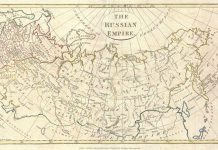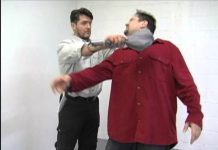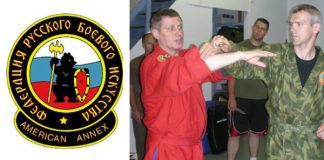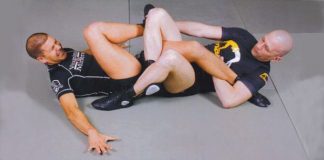SAMBO, the English translation of the Russian acronym meaning “self-protection without weapons” (SAMozashchitya Bez Oruzhiya). SAMBO is a curriculum of martial tricks, covertly taught in the former Soviet Union to the Soviet special forces (‘Spetsnaz’), since the Communist Revolution in October of 1917. Sambo has been the object of a voluminous amount of clandestine research, experimentation, and propaganda. For this very reason, Sambo was the Soviet attempt to suppress the patriotic and liberating tendencies of indigenous Slavic martial traditions, entitled “Russian Martial Art”. Sambo was the Soviet hope to unify the State under one combat and one sport. A composite of 25 variant Russian style hand-to-hand combat systems, Sambo added complementary research from various European, North African and Middle Eastern influences. Weighing also upon the formulation of Sambo were some Asian influences from Jujitsu, Aikido and Karate. Melding these combat systems with the 25 national folk styles of wrestling, Sambo came into being.
Imagine, if you will, the entire political engine of the former Soviet Union charged to research the full spectrum of human combat. All of the State’s economic mechanisms were mobilized to investigate the peculiarities and characteristics of human confrontation. The vastness and depth of such an endeavor is difficult for any one individual to grasp. In the history of humankind, there has never been such an awesome pursuit for information into combat; there has never been a deliberate, State-sanctioned mandate to create a sovereign martial system to be employed by it’s constituent military organizations.
In 1918, comrade V. I. Lenin created Vseobuch: the organization responsible for training the Red Army. Joseph Stalin, at the time a string aid to Lenin, personally ordered a high ranking political official, named comrade Voroshilov, to organize research into human combat. Voroshilov was a an inept monster, personally responsible for hundreds of military blunders. Although incompetent and inhumane, he accomplished one grand measure, accidentally. Not wishing to toil over such a “mediocre” endeavor, in 1923, he formulated a group called the “Dynamo” to do the research.
Voroshilov assembled a retainer of combat-experienced individuals to carry out this endeavor: A. A. Kharlampiev, V. A. Spiridinov and V. S. Oschepkov. Each of these individuals were assigned the vocation of combatives investigators and sent to travel to various countries to study the endemic, native combatives. Anatoly Kharlampiev traveled west then south absorbing the Euro-Asian and Afro-Baltic combative systems. V.S. Oschepkov traveled to Japan. V. A. Spiridinov traveled to Mongolia, China, and India to study the Mongol-Vedic martial traditions. Although returning sporadically to deposit information and engage in political endeavors, the course of this investigation lasted approximately ten years.
To Asian styles such as, JuJitsu, Karate, Judo, Kung-fu and Aikido, the men added their experience with the native, Russian hand-to-hand combat, known only as “Russian Martial Art”.
The reservoir of information on this investigation was to be controlled by the State. Here is the origin of what became a State-authorized falsification and distortion of technical data on Soviet combatives. Voroshilov was ordered to establish a secret, hierarchical structure to the information. At the highest and most remote level, a Close Quarters Combat system was to be devised for training by the elite forces of the former Soviet Union Special Forces and Secret Police. This Soviet Close Quarters Combat (CQC) training methods were tested for effectiveness in the Russo-Japanese War and World War I. The intent of close quarters combat was for silent killing by covert forces, personal combatives by elite forces, and torture methodologies by interrogative forces. Various combative tools were employed. Unarmed tactics such as debilitating strikes, dangerous captures, suffocation and strangulation methods, and Armed tactics such as spade, saber, bayonet, knife, baton, and pike usage were included in the curriculum. The goal of CQC is the total destruction of the enemy in the most expedient manner: a purely military doctrine.
A second tier of the system was to be employed by the general Soviet Police. This form was to be the Soviet Police Subject and Crowd Control Tactics (CCT). The CCT were fashioned into a system of Balance Displacement measures, Pressure Point Control Tactics, Joint Manipulation, and striking tactics aimed at Motor Dysfunction and Pain Compliance, and mob control weaponry, such as impact weapons and chemical agents.
Finally, at the basal level, the combatives information was to be intentionally diluted into a competitive form which would become the training regimen of the general military. In this manner, a system of personal combatives would be issued to the military that was deliberately fashioned for one purpose: information seepage into other countries. In order for the deception to be believable, not only must the new system be effective, but it had to appear to be some revolutionary advancement in training. This diluted sport form was easily trained in by the general military, who did not require advanced skills training. They had to be fit and healthy. They fought with great spirit and élan, not because they were the best prepared or best equipped, but because they were members of the ‘People’s Army’. Such a schism between the training of the grunt militia and the officer elite was not a Soviet invention, but an historical characteristic of ancient Russian martial traditions.
Voroshilov ordered V. A. Spiridinov, an officer of the Russian Army participating in the First World War, and V. S. Oschepkov, the first Russian black belt in Judo, to produce Sport SAMBO. After the October Revolution, Spiridinov became one of the training experts of combat SAMBO and aided in it’s formulation. To create Sport SAMBO, he relied upon his background in American free-style wrestling, Pankration, Greco-Roman wrestling from the Baltic States, Georgian “Chidaoba”, Moldavian “Trinte”, Yakut “Khapsagay”, Armenian “Kokh” – the national style of wrestling of Armenia, Chuvash “Akatuj”, Turkish “Kuresh” belt-wrestling from Azerbaijan,. Spiridinov was also a master of Japanese JuJitsu. V.S. Oschepkov, reared in a Japan and training in the Kodokan-judo institute was a master the Japanese combat art of JuJitsu. While in Japan, he became a close personal friend of JuJitsu master, Professor Jigora Kano, who later created the fourth style of international wrestling: Judo.
The collaboration and friendship between Oschepkov and Kano is of marked interest. Both men agreed that the most effective method of mastery was through a technique named: method sequencing or ‘kata’. These men coordinated their efforts at cataloguing the most common and frequent forms of attack. From that they codified what would be the most expedient neutralization of the threat. It is because of this work that many contemporary Judo and Sambo practitioners are fragmented into two camps: those that prepare for combat through sequence rehearsal, and those that enjoin the competitive aspect to determine their prowess. Kano was an extremely insightful man revolutionizing martial arts training with his expertise in education. Oschepkov was outfitted with a most powerful instructional method, and carried it back to Russia, where he instructed studies in combat at the Central Red Army House and the Moscow Institute of Physical Culture.
The nucleus of SAMBO is eclectic in nature, as Spiridinov said, “While self-defencing, it’s impossible to use only one system… it’s necessary to use all useful methods from other systems, if it leads you to victory.” Method Sequencing should not be rigid, it is only a guideline. Differing body types (both of the defender and of potential attackers), differing terrain, differing indoctrinations (civilian, military, police, sport) dictate the sequences in which to be trained. Individuals should not be told what to do, but educated in judgment, so that they might assess proper training methodologies.
Though having little involvement with the technical and tactical formulation of this system, Voroshilov had established the hermetic integrity of the system by virtually offering the ‘secrets’ of the USSR’s combatives to the espionage of competitive nations. Everyone would believe that they knew, or even trained in, the Soviet combatives system; even the natives would be convinced by this official version of SAMBO. Here is the important part… Even today, in the enlightened technological era, Russians, who have trained in military SAMBO, or athletes that were champion of this district or that sector, are convinced that they know what SAMBO is. However, True Sambo, known as “Combat Sambo Spetsnaz” or “the System” was something altogether different; it was the ancient Slavic martial traditions, hidden from State observation. In actually, at the highest levels, Sambo is actually Russian Martial Art.
By placing an impure form of information for global consumption, the actual information remained unexplored: an act of unadulterated, political genius.
To name the system, attempts were first made at “SAM,” then “SAMOS”, and finally the group agreed upon SAMBO, an acronymic title meaning “SAMozaschityz Bez Oruzhiya” or “Self-protection without weapons”. Voroshilov continued with his political maxim of ensconcing the truth by supporting this title – SAMBO. The CQC and CCT system of SAMBO comprised not only unarmed tactics, but a wealth of armed training. All the while, the deceptive name of “self-protection without weapons” perpetuated the illusion that SAMBO was merely a wrestling style and exclusively concerning unarmed engagements.
Training was held by a group of experts, who became the progenitors of SAMBO throughout the nation and the world: A. A. Kharlampiev, V. A. Spiridinov, V. S. Oschepkov, N. I. Golkovsky, I. V. Vasiliev, A. I. Chumakov, S. V. Magirovsky, V. I. Andreev, D. S. Damanin, V. F. Maslov, A. A. Budzinsky, and the brothers Niniashvili. The group was given the name, the “Dynamo,” and was established in 1923. Each of these individuals equally contributed to the extensive research made into the psycho-physiological reactions to the high-stress crisis of physical confrontation, the psychology of combat survival skills, and the surveillance of the legal, medical, and tactical acceptability of combat activity; as well as, exploration of the technical considerations. In 1930, SAMBO became the curriculum of the State Central Institute of Physical Culture in Moscow.
Prior to receiving recognition for the masses of information he contributed to the formulation of SAMBO, V.S. Oschepkov was shot in the head during the political purges of 1937. Ironically the following year, Spiridinov completed the Sport section of SAMBO and, on November 16, 1938, received recognition by the All-Union Committee on Physical Culture and Sport that SAMBO was the national wrestling style of the Soviet Union. In 1966, FILA, the International Amateur Wrestling Federation, recognized SAMBO as the third style of international wrestling. In 1981, the International Olympic Committee recognized SAMBO as an Olympic Sport.
Rumor has it, that Oschepkov outright refused to contaminate all of the work on SAMBO for the benefit of political paranoia. For treason, Oschepkov was sent to the Gulag (prison camp) and summarily executed for his political crimes. The remainder of the group trembled because of their association with what Voroshilov claimed to be “convicted spies from Japan and other imperialists – capitalists.” They wished to live, so they acquiesced to the yoke of Voroshilov’s cut-throat diplomacy. Kharlampiev wrote many manuals on SAMBO and became Voroshilov’s greatest voice in communicating the “official” version of SAMBO. Others remained pensively obedient until the time came when the truth could be told.
Although a handful of individuals that engaged in Soviet SAMBO training have migrated to the United States, these ex-USSR military personnel, in their filtered understanding of the origin and purpose of SAMBO, have been as deceived to the true nature of SAMBO as other nations have been. Remember, Voroshilov intentionally submitted Sport SAMBO training to the general military; this was the “official” version. In addition to this, the field combatives taught to the Soviet military were labeled as SAMBO. In this manner, only the special and elite forces trained in the true system. As these low-level military operatives enter into the United States claiming SAMBO training, the illusion created by Voroshilov is perpetuated into the American martial arts community. Only one man in North America trained in Russia in “Combat Sambo Spetsnaz” also known as Russian Martial Art, the ancient Slavic martial traditions.
As the yoke of the oppressive Soviet regime lifted, the information and the truth concerning its intentional covert nature and the wealth of research and experimentation became available to rest of the world. With the veil of deception removed, Sambo is recognizable in its ultimate origin: Russian Martial Art.
Although Russian Martial Art is the mother of Sambo, due to the influence of foreign “tricks”, Sambo soon became a mere curriculum of techniques lacking any high degree of depth and substance. To avoid Soviet attention, Russian Martial Art remained in practice under the concealed title of “Combat Sambo Spetsnaz” at higher levels within the military, among the elite combat subdivisions of Spetsnaz. Even though classified with the label of “absolute secrecy”, the training was often referred to merely as “The System”.
Sambo continues to be confused with Russian Martial Art because of the state-fashioned falsification and distortion of historical and technical data, as well as the vanguard protection of Russian Martial Art heritage under the guise of the title, “Combat Sambo Spetsnaz”.
The contemporary training of ancient Slavic martial traditions, culminating from 1,500 years of practice and development, is known as ROSS – “All-Russian Native Self-Defense System”. ROSS is the national training system of Russian Martial Art, approved and recognized by the National Olympic Committee of Russia as the only representative of Russian Martial Art, within Russia and abroad.
The original royal family lines of pre-Soviet Russia, during the century of Soviet oppression, were not without alternatives for their sons. Entering their sons into the most grueling and dangerous military teams in the USSR, the Spetsnaz, allowed them to hide the ancient Slavic martial traditions under the deceptive title of “Combat Sambo Spetsnaz.” The sons of the royal families continued their training among the special operations units of Spetsnaz in order to select elite, trustworthy individuals with which to share the truth about the origin, nature and characteristics of Russian Martial Art. The difference between Sambo and its mother, Russian Martial Art, becomes easily distinguishable to the experienced practitioner. One family, the Golitsin family, survived the entire lifetime of the Soviet Union. Prince Boris Vassilievich Golitsin, in particular, trained few individuals including the Founder of ROSS, Golitsin’s student prodigy, Commander Alexander Ivanovich Retuinskih. Prince Golitsin attended the induction ceremony of the founding members of the American Academy for Russian Martial Art and Combat Skill, Scott Sonnon, to give special insight and training to the American, and to offer his personal blessings to Commander Retuinskih’s decision to induct Sonnon as a student of Russian Martial Art.
The fourth period of influence in the development of Russian Martial Art (“Global Period”) dealt with the nature of combat during this century (for more information on the history of Russian Martial Art, visit). Therefore, weapons adopted by the Russian Martial Artist included bayonet-equipped AK47 machine gun, the earlier SKS rifle, even earlier carbine, the spetsnozh (special forces knife/bayonet), entrenching tools , throwing knives, batons, military belts (used as whips and immobilizing shackles), pistols, sword (European sabre and Cossack shashqa), axe, and a wealth of non-standard weapons. The many wars and battles of this century are a horrific testimony to the effectiveness and longevity of the Russian Martial Art; its vanguards, the trainers and elite operatives of the Russian Special Forces, waged campaign after campaign with unequivocal success. This period of influence eventually evolved, once again, with the dissolution of the Soviet Union into a form of civilian empowerment and rejuvenated cultural heritage and pride.

